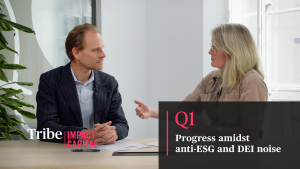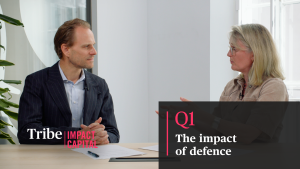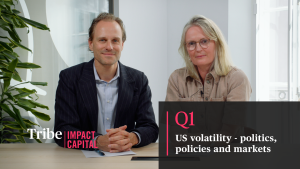CIO 2022 review & outlook

As another year draws to a close, there have been three stand out themes that have largely defined 2022.
Sustainability backed regulations
Continuing from 2021, the strong market sentiment for sustainability hasn’t waned, even in the face of what has been a tumultuous year in markets. There’ve been a number of high-profile developments in policy and regulation that have further integrated ESG into mainstream finance. The new EU green taxonomy, the EU Sustainable Finance Disclosure Regulation (SFDR), issue specific regulations relating to the clean energy transition including REPowerEU and the Inflation Reduction Act in the US, are a few of the new policy frameworks deployed this year. These have laid the foundations for a wholesale shift in both governance and transition.
The tightening of “regulatory rules” around greenwashing has continued apace with the advent of the EU’s SFDR and green taxonomy. This led to a significant number of funds being
re-rated on their ESG credentials and downgraded by Morningstar
1
. Further tightening is expected with new proposed rules outlined by the European Securities and Markets Authority (ESMA), aimed at
protecting investors and stamping out greenwashing
2
. In the US, the Securities and Exchange Commission (SEC) proposed new rules to
enhance and standardise climate-related disclosures for investors
3
.
More draft frameworks and consultations were upgraded and launched during the year including the International Sustainability Standards Board (ISSB) exposure draft, the Taskforce on Nature-Related Financial Disclosures (TNFD) beta framework v0.3 (
in advance of COP 15
4
) and the UK government’s consultation on the proposed Sustainable Disclosure Requirements (SDR) for the UK market – to name a few. If 2021 was the year the foundations for the great transition were laid, 2022 has further cemented those foundations and mainstream implementation has now begun. And finally, just as the year closes, the new
23 point Kunming-Montreal Global Biodiversity Framework was agreed at the Convention on Biological Diversity in Montreal (COP15)
5
setting the scene for clear guardrails finance and business must work within.
Market volatility
The energy crisis, sparked by the invasion of Ukraine by Russia in February, and the ensuing spike in fossil fuel prices, prompted governments and investors to start thinking seriously about energy security. Whilst the significant increase in the price of fossil fuels benefitted oil and gas companies, renewable energy providers were left suffering ongoing supply chain issues and planning blockages. The slow pace of the release of EU funds and policies from the REPowerEU programme has meant the major boost in activity from this sector still lies ahead.
Our expectation is that this is just the beginning of a significant regulatory tailwind in support of the sector. The International Energy Agency (IEA) highlighted this, raising its global forecast for renewables power generation growth in December 2022 to what it calls its “largest ever upward revision” for the sector. The agency’s latest revision now forecasts 76% more growth than it did just two years ago 6 .
Inflation and the cost-of-living crisis
Rising prices have been the dominant theme for financial markets all year. In January, concerns about stickier inflation deepened in February with the onset of Russia’s war on Ukraine, which squeezed both energy and food markets. This compounded the backdrop of supply chains struggling to adjust to a world largely moving on from Covid-19 (with the notable exception of China) and households sitting on cash savings accumulated during the pandemic. In response, central banks globally were forced to raise interest rates aggressively, with further hikes expected, albeit at a slower pace in early 2023.
Overall, we believe inflation has peaked in the developed markets and should continue to trend downwards as the costs of shipping and certain commodities normalise back to 2021 levels. However, we suspect markets may be too optimistic in hoping for rate cuts in the back end of 2023 due to ongoing inflationary forces from de-globalisation and the added costs associated with ensuring businesses comply with higher standards of sustainability and responsibility.
Looking towards 2023
There are some big themes we believe will continue to dominate in 2023. We’re at the start of a longer-term rewriting of many of the rules and policies that underpin business behaviour and global finance. 2021 7 and 2022 have demonstrated that movement is underway. We expect more to follow in 2023, with the finalisation of many of the draft management and disclosure frameworks currently in consultation and use, as well as regulations (for example, the UK’s SDR regime which will roll out in 2024).
Equities
We continue to remain cautious which is reflected in our relatively low allocation to equities. This is currently at the lowest weighting within portfolios since our inception. This caution is primarily based on our view that US equities, which represent 63% of the MSCI World Index 8 , appear expensive, despite posting double digit losses in 2022. The valuation multiple at which earnings are being priced, still sits nearly 10% above the last ten-year average, even though current market expectations are for earnings growth in 2023. This seems ambitious, as we believe a shallow recession is likely, meaning the effective premium is in fact higher still.
We’re slightly more positive on equities outside the US. The EU economy continues to struggle with high inflation, driven by both high energy and food prices. We see a recession in the EU as a near certainty, yet, should this be shallow or short-lived there are likely to be buying opportunities here. The EU market is trading at more than a 10% discount to the average multiple of its earnings over the last ten years. We remain constructive on emerging markets. In 2022 we saw signs of decoupling from their reliance on the developed world’s economic cycle because they haven’t faced the same inflationary pressures.
There will be increasing focus on active ownership in public equities and the allocation of capital to purposeful and solutions-based companies. For example, there is the potential addition of auditing being added to the mix (specifically the independence of auditors and their role in adequately addressing the risks of externalities on balance sheet). We anticipate more thematic funds coming into the markets, specifically in food and biodiversity related areas, as well as in emerging markets, where investor backing for companies transitioning and providing solutions is hard to come by.
Fixed income
With the shift in interest rates, fixed income has become attractive again for many investors. Fixed income can play a role in transitioning companies quickly and we hope that 2023 will see more, higher quality fixed income instruments for investors to engage with. We also hope to see more innovation, at greater scale, like the Wildlife Conservation Bond (WCB) the World Bank issued during 2022 9 . Because debt provision can be linked to performance outcomes and broader strategic key performance indicators (KPIs), we hope to also see a rise in the issuance of quality Sustainability-Linked Bonds (SLBs), green bonds and social impact bonds, both at the corporate and sovereign level.
In bonds, we’ve become more positive following a large sell off during 2022, as government and corporate bonds saw their value eroded by increasing inflation. We expect that each of the Bank of England, the European Central Bank (ECB) and the US Federal Reserve will still need to raise interest rates into early 2023 to counter continued high inflation, although the risk of a further surge in price pressure should be limited. As a result, we believe market forecasts for where “peak rates” will reach are in the right zone, providing an anchor to begin re-building exposure. As we cited in our recent piece time in vs timing , bond valuations have recovered to a level that they can be used to complement equity positions by both providing some yield and capital gain.
Alternatives
Our highest conviction positioning in 2022 was seeking high exposure to alternatives: companies and investments with less sensitivity to the economic cycle. One of our core allocations, microfinance, along with newer additions, such as forestry and carbon trading schemes, have delivered strong gains since first being introduced to portfolios. Renewable energy trusts have benefited from higher power prices, in spite of recent UK legislation for tax revenues earned above a certain energy price point. We continue to like these securities into 2023, but the relative attraction versus fixed income is less pronounced, and we’ve been switching our allocation accordingly. We anticipate seeing more thematic investment trusts entering the market aimed at delivering capital to highly impactful activities.
2022 has been a very mixed year. With this in mind, we expect 2023 will be a year of consolidation. We don’t expect a repeat of 2022 – which was only the third year in the last century that we’ve seen negative returns in both bond and equity markets (the others being 1931 and 1969). Our focus will remain on how inflation is impacted by the strong labour market in the US and the energy market in Europe – and how its trajectory shapes whether the Federal Reserve and other central banks will be able to manage setting interest rates without causing a deep recession. We continue to believe that finding ‘well run business, solving global challenges,’ is just good investing.





